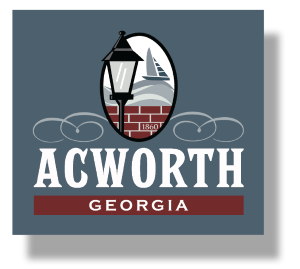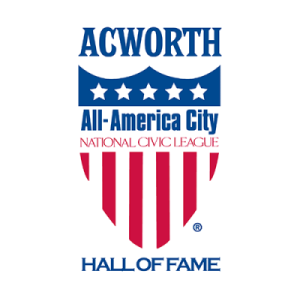Historic Acworth
Address:
Acworth City Hall
4415 Center Street
Acworth, GA 30101
The history of Acworth High goes back into the 1800’s. It seems the old building that was used for the elementary grades, was once known as Acworth High, as well as the Smith-Lemon Institute. On May 29, 1899, the trustees of Acworth High School petitioned the Cobb County Superior Court to issue them a charter for the Smith-Lemon Institute, changing the name of the school. Mr. Bernard Awtrey was the principal.
By 1925, Cobb County began to look to consolidate many of the small schools into larger and better schools. Acworth and Marietta were the only two towns in the county that did not participate in the consolidation. Acworth qualified for $1,000 per year from the State of Georgia to pay the salaries of a high school teacher, provided rural children were allowed to attend the school. From 1925 until 1935, Acworth compensated in this manner, and a bus transported students in grades 8-11 from County Line, Allatoona, and Mars Hill schools to attend Acworth High School. Somewhere along the way, the name had been changed again from Smith-Lemon Institute to Acworth High School.
During the middle thirties, PWA built the building that is known as Acworth High School. It was a college preparatory school, with grades one through eleven, with a 12th grade being added in 1954. For some years Acworth was the only county high school and students came from across the western side of Cobb County by bus. Student life consisted of sports of football, baseball, basketball, and track (none of the golf, tennis, soccer, etc. of today). Also, there were various clubs and organizations. The school paper was known as the Transmitter,” and the yearbook the Retro. The school colors were orange and black. The highlight of the year was the Junior-Senior Prom each May when all the juniors and seniors dressed up and were allowed to stay out past midnight. Also, a highpoint was receiving the Retro and having it signed by all your friends and teachers.
In 1951, the Cobb County Board of Education wanted to build a high school for Kennesaw and Acworth. A bond issue was passed. In 1957, a new high school was constructed between Acworth and Kennesaw and was called North Cobb High. Residents of Acworth were reluctant to give up their high school that had a very special place in their hearts. Old timers were sad when the Lemon-Smith Institute was torn down to make room for a new building, and now they were sad again to have the high school moved out of the city limits. Acworth High School served as an elementary school until May of 2001. In the fall of 2001, the new Acworth Elementary School opened.
Principals of Acworth Public Schools 1920-Present
- G.W. Futch
- L.D. Singleton
- T.J. Harvey
- W.P. Sprayberry
- J.D Ramsey
- T.C. Cantrell, Jr.
- Joe F. Hays
- David Taylor
- Albert L. Price
- Don Sawicki
- Gail Phillips
The Bethel AME Church congregation was organized in Acworth in 1864, originally sharing a church building with the Zion Hill Baptist Church. In 1871, trustees of the Bethel AME Church purchased one acre of land, and the present sanctuary was constructed sometime between 1871 and 1882.
The Romanesque Revival-style church has round-arched windows and decorative brickwork in the gable areas. The front vestibule and two asymmetrical bell towers with conical metal roofs were added in 1895, and a rear addition was constructed in 1973. The interior of the sanctuary is arranged as a central-aisle plan and exhibits a magnificent wooden coffered ceiling constructed in a herringbone design.
Bethel AME Church was listed in the National Register of Historic Places in 2002, and designated as an Acworth Historic Landmark in 1998.
The Collins Avenue Historic District is a collection of late nineteenth-century Victorian-era houses and early twentieth-century Craftsman-style bungalows that was placed on the National Register of Historic Places in 2001, and designated as a Local Historic District by the City of Acworth in 1998.
The district represents two periods of development for Acworth. The first period, 1890-1910, includes most of the structures located towards the southern end of Collins Avenue (including the Collins-Smith House which was built around 1850, and was once part of a 200 acre farm). The McMillan-Parks House, built in 1897, was moved to the northern end of Collins Avenue in the early 1980s.
The latter period, 1920-1930 is represented by four Craftsman-style bungalows which were constructed by Frederick J. Kienel, general manager of the Unique Knitting Company who had located a mill in Acworth in 1928, using plans taken from Atlanta architect Leila Ross Wilburn’s pattern book Ideal Homes of Today.
The Cowen House was constructed in 1854 by Stephen D. Cowen, a prosperous farmer who migrated to Acworth from Virginia in the early 1850s. Originally part of a 1200 acre farmstead, the Cowen House survived the Union occupation of Acworth by General William T. Sherman in 1864 and now sits on approximately one-half of an acre, the remainder of the land having been sold off after Stephen Cowen’s death in 1900, when the property was divided among his heirs. In 1918, the house was sold out of the Cowen family and is presently owned by the Acworth Society for Historic Preservation.
The Cowen House is an excellent example of a pre-Civil War plantation plain-type structure, a house style that is a version of what is more commonly referred to as an I-house: a two-story house usually two rooms wide and one room deep with a side-gabled roof structure. The I-house was popular because its balanced, symmetrical fade appealed to an increasing interest in classical architecture and was viewed by farmers as a symbol of economic attainment.
Placed on the National Register of Historic Places in 2001, the Cowen Farmstead was also designated as an Acworth Historic Landmark in 1998.
Acworth’s historic downtown once served as the community’s primary central business district, in the days before the automobile made possible the development of commercial strip centers and shopping malls which could be located farther from the core of the city.
Present day Main Street is located on what began as a trading route used by the Cherokee Indians, and by the 1920s, it had evolved into a major North-South thoroughfare known as the Dixie Highway (later replaced in the modern era by Highway 41 and Interstate 75).
Part of the historic area of the city is being considered for inclusion in the National Register of Historic Places, an honorary designation given by the United States Department of the Interior. Acworth’s downtown buildings still retain many of the architectural details commonly associated with commercial buildings constructed in the late nineteenth and early-twentieth centuries, and serve as a physical reminder of a point in time when the downtown was the focus of small town life.




